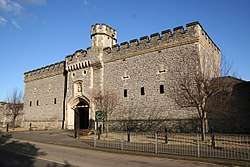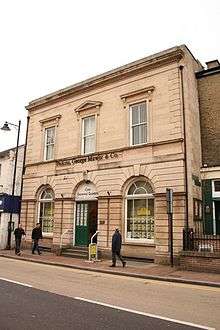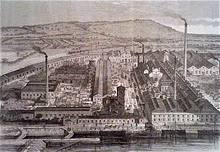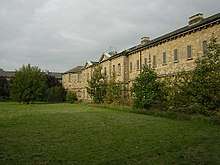Henry Goddard (architect)
| Goddard, Henry | |
|---|---|
 The Drill Hall, Broadgate, Lincoln 1890 | |
| Born |
1813 Leicester |
| Died |
8th. March 1899 John of Gaunt’s House, Lincoln |
| Nationality | English |
| Occupation | Architect |
| Practice | Partner with W A Nicholson. |
Henry Goddard (1813-1899) was an English architect who was a member of a family of architects who worked in Leicester. He moved to Lincoln and was later in partnership with his son Francis Henry Goddard.
Career
In 1838 he came to Lincoln and formed a partnership with William Adams Nicholson. In 1846 he established his own practice in Lincoln and in 1856 was working from 181 High Street.[1] He became architect to the Great Northern Railway Company and surveyor to Trinity College, Cambridge.[2] From 1860 to 1864 his senior assistant was William Watkins, who was to set up his own architectural practice in Lincoln. In 1871 the Nottingham architect Albert Nelson Bromley was working in Goddard's office.[3] Goddard was in partnership with his son, sometime after 1872, at City Chambers 182 Lincoln High Street, where the practice remained until at least 1896.[4]
Family
Goddard was the nephew of Henry Goddard (architect 1792-1868) of Leicester and cousin of Joseph Goddard (architect 1840-1900), also of Leicester.[5] Care should be taken not to confuse the work of Henry Goddard and Goddard and Co. of Leicester with that of Henry Goddard and Goddard and Son of Lincoln. For work of the Leicester architects see The Goddard Trail[6]
Works



Initially Goddard appears to have specialised in Church building and Rectories and Vicarages. He probably followed Edward James Willson as the Surveyor to the Lincolnshire County Committee and, following the Militia Act of 1852, was commissioned to build the Old Barracks in Lincoln for the North Lincoln Militia. It has also been suggested that he may have been responsible for the Old Barracks in Sandon Road in Grantham for the South Lincolnshire Militia.[7]
Public and Commercial Buildings

.jpg)
- Great Northern Hotel, Peterborough.
- Great Northern Hotel and Great Northern Vaults, 177 High Street (west side), Lincoln 1847 but formerly ‘’ The Black Boy’’. By Henry Goddard, but possibly incorporating parts of an earlier building. All demolished c.1959. Behind, facing the railway was 13 bay range incorporating 18th century features.[8] On the opposed side of the street the Great Northern Vaults, also by Goddard. This was presumably a wine and spirits storage deport with an Italianate tower with a large entrance arch and two wings facing onto the High Street, just too the south of the existing railway crossing. All demolished apart from a portion of the southern wing which still fronts onto the High Street
- Market Rasen, Corn Exchange. 1854. Stone faced Italianate facade.[9]
- The Old Barracks in Lincoln (now occupied by the Lincolnshire Life Museum), 1857.[10]
Houses
.jpg)
- Lincoln Hartshome Hall,[11] was built in 1862 for the industrialist Joseph Shuttleworth. The grounds were laid out by the landscape architect Edward Milner and included a lake, imported and native trees and shrubs, yew trees forming the Ladies’ Walk, a yew circle, a small crescent-shaped pond and a ha-ha.[12] Surviving buildings and structures include the boathouse (built in 1881 and bearing the Shuttleworth Crescent), stables, a lodge along the track leading to Doddington Road, balustrades and steps, and a number of monuments including the obelisk on the north side of the lake. T Hartsholme Hall itself was demolished in 1951 after being purchased by Lincoln City.[13]
- Owston Ferry, Lincolnshire. Old Vicarage, 1866.[14]
- Scawby. Alterations to Old Vicarage, 1868.[15]
Church Restoration
Cemetery
- Lincoln Cemetery, Canwick road. Laid out by Goddard 1856.[19]
H and F H Goddard
Partnership after 1872.
Work by the Goddards for the Lincoln Industrialists

The rapid growth of Lincoln in the mid to late 19th century provided considerable opportunities for undertaking architectural work for wealthy factory owners who were involved in the engineering and metalworking industries. This work involved the design and layout of factories, the provision of housing, the laying out of new streets and the construction of the villas and residences of the factory owners. The Goddards seem to have developed a close relationship with Joseph Ruston who was the managing director of Ruston, Proctor and Company. The Goddards were are likely to be the architects of his house, Monk’s Manor on Greetwell Road in Linoln. They also provided new offices for Ruston Proctor on their Stamp End Sheaf Works [20] Joseph Ruston also financed the building of the Drill Hall in Broadgate for which Goddards were the architects. [21] The Goddards also untook extensive design work for Clayton & Shuttleworth who occupied the adjacent site to Ruston Proctor at Stamp End. A print of 1865 of their ironworks would suggest that they had been closely involved in the layout of the factory. An Italianate tower in the central foreground appears to be a hallmark of their work and is seen again on the Great Northern Hotel depot building and on Ruston’s Monk’s Manor. They were to add further offices to this complex in 1878. [22] The Goddards also designed Hartsholme Park for Joseph Shuttleworth. Another factory complex that was laid out by the Goddards was the new Wellington Foundry on the Derby Farm in New Boultham in 1883.
Public Buildings

- Lincoln, The Drill Hall, Broadgate. 1890. The architect was Major F. H. Goddard of Goddard and Co. It was built at the cost of £10,000 which was funded by Joseph Ruston. It was created as a result of the 1863 Volunteer Act and was to provide drilling facilities for the !st Lincolnshire Volunteer Battalion.[23]
- St John's Hospital, London Road, Bracebridge Lincolnshire. County Asylum, now converted into housing. Built between 1849 and 1852. Addition in 1880-82 of two wings to the original building by F.H. Goddard of Lincoln-the builder was W. Pattison.. This brought the capacity of the hospital to 680. Goddard was also the architect for further additions built in 1897.[24]
Bank
- Barclay's Bank, High Street. Lincoln. 1873. Stone of three storeys with a parapet and ornate cornicing. The ground floor with a Romanesque revival doorway and two windows in Romanesque style. On the corner of High Street with Cornhill. Demolished in 1973 or earlier and replaced with present building by Sam Scorer[25]
School
- Brigg Grammar School extension 1878.[26]
Houses
- Bourne Vicarage [27]
- Sturton by Stow. Additions to the Rectory. 1866 [28]
- Spridlington Hall (former Rectory). Additions 1878.[29]
Church Restoration
- Swayfield, Rebuilt part of church1875-6.[30]
- Timberland. Restoration of church, 1887.[31]
- Normanby by Spital. Restoration of church in 1890.[32]
Literature
- Antram N (revised), Pevsner N & Harris J, (1989), The Buildings of England: Lincolnshire, Yale University Press.
- Antonia Brodie (ed), Directory of British Architects, 1834–1914: 2 Vols, British Architectural Library, Royal Institute of British Architects, 2001, Vol 1, pg. 735.
- Brandwood, G.K. and Cherry, M.(1990), Men of property, the Goddards and six generations of architecture Leicester Museum Service.
- Obituaries. (1899) Building News, vol. 76, pg.369. Builder, vol. 76, pg.281. Times 11th March 1899, pg. 10.
References
- ↑ White's Directory, (1856), pg. 127
- ↑ “Brodie” 735
- ↑ "Brodie", (2001), 263.
- ↑ Kelly's Directory of Lincolnshire, 1896. pg.350
- ↑ “Brodie” 735
- ↑ Goddard Trail
- ↑ ”Antram”, 326
- ↑ Pevsner N & Harris J, (1964), The Buildings of England: Lincolnshire, pg 162.
- ↑ ”Antram”, 556
- ↑ ”Antram”, 507
- ↑ ”Antram”, 526
- ↑ ”Antram”, 526
- ↑ Heritage Connect
- ↑ ”Antram”, 597.
- ↑ ”Antram”, 626
- ↑ ”Antram”, 624.
- ↑ ”Antram”, 380
- ↑ ”Antram”, 496.
- ↑ ”Antram”, 502
- ↑ Survey of Lincoln. Lincoln City Building Application 1213,25/05/1881
- ↑ Survey of Lincoln. Lincoln City Building Application 1889,21/01/1889
- ↑ Survey of Lincoln. Lincoln City Building Application 925 13/02/1878
- ↑ Hubbard Hall, c. in Walker A ed. (2015) Lincoln's City Centre: North of the River Witham The Survey of Lincoln, pp65-68.
- ↑ Pastscape
- ↑ Elvin L Lincoln as it was, Hendon Publishing. Unpaginated - illustrated
- ↑ ”Antram”, 185
- ↑ ”Antram”, 175
- ↑ ”Antram”, 728-9
- ↑ ”Antram”, 682
- ↑ ”Antram”, 736
- ↑ ”Antram”, 766
- ↑ ”Antram”, 579
External links
| Wikimedia Commons has media related to Henry Goddard (architect). |